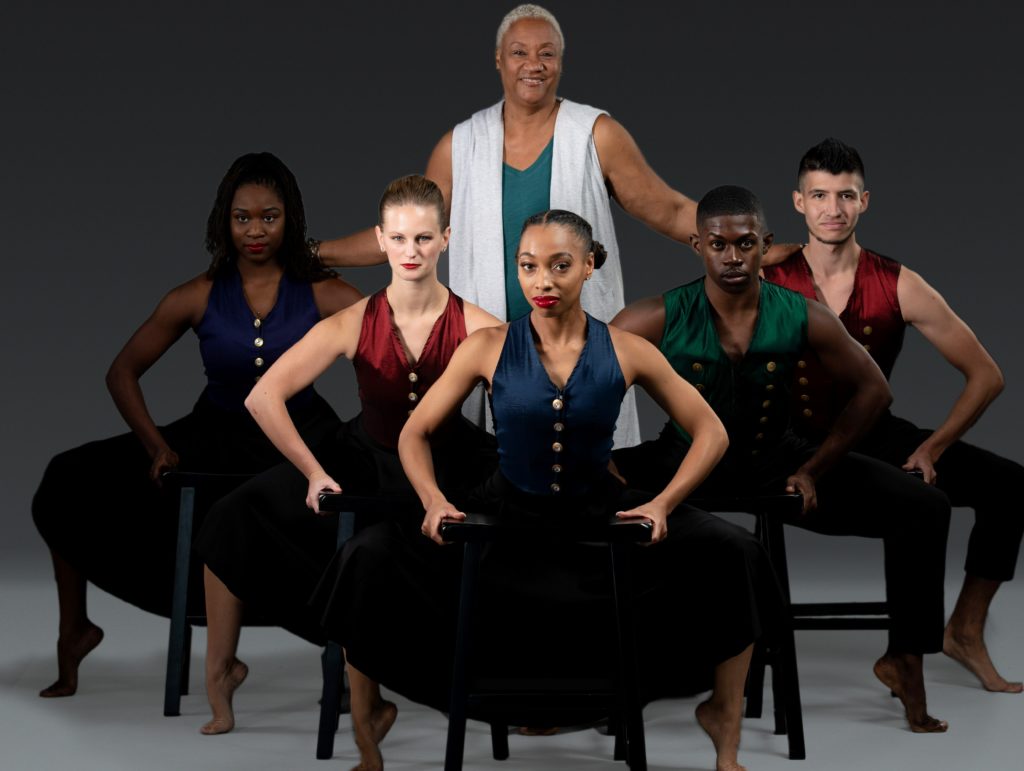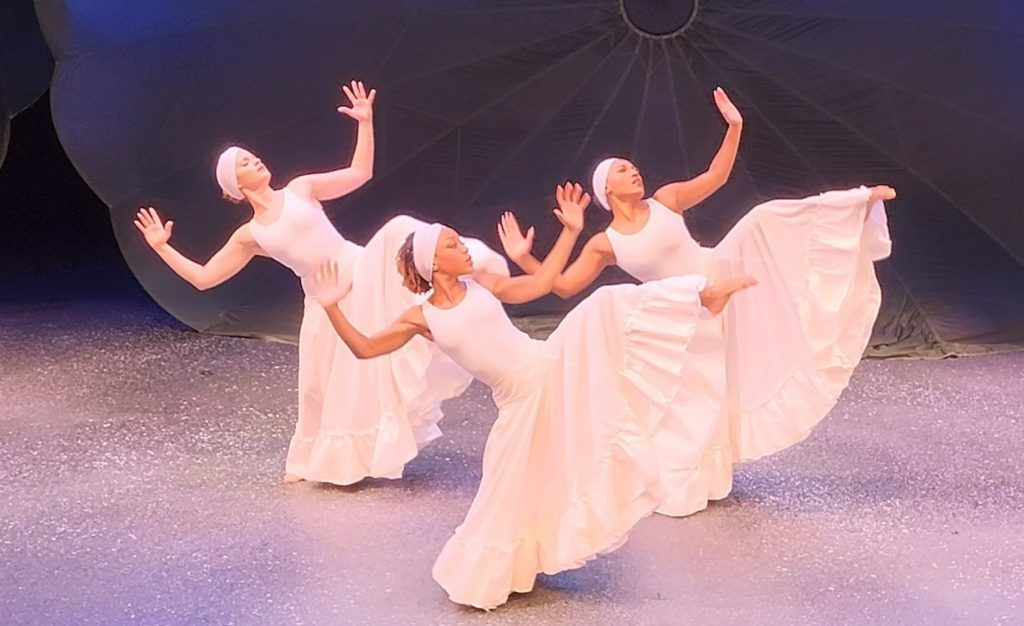Dayton Contemporary Dance Company is the modern Black dance organization in the area. Known in Dayton, it also draws dancers from across the country and performs in places like New York. Its mission is to be a culturally diverse contemporary dance company committed to teaching the broadest audience for exceptional performances and arts-integrated education.
Its vision is transcending human boundaries through contemporary dance. The company has four goals: maintain excellence, diversify revenue streams, amplify work locally, regionally and internationally, as well as engage technology and digitalization.
Founded by Jeraldyne Blunden in 1968 for dancers of color, the company is now in its 54th season with this year’s theme of “Etchings,” blending past traditions of local and world community through art and dance with a Black perspective. Blunden studied with such major dance figures as Martha Graham, George Balanchine and James Truitte. She has honorary doctorate degrees from the University of Dayton and Wright State University.
Jeraldyne’s daughter Debbie Blunden-Biggs studied ballet as early as eight-years-old at the Short Dance Studios for the Performing Arts. She attended Fairview High School and Sinclair College while continuing private dance training. She spent her summers from ages 14 to 22 at the Alvin Ailey American Dance Theater in New York City. Her parents supported her efforts in New York, but gave her time to reassess the situation if it didn’t work out.

(L to R) Nicolay Dorsett, Willa Marks, Alexandria Flewellen, Aaron Frisby and Robert Pulido. Choreography by Blunden-Diggs. Photography by Scott Robins.
“My parents were giving me a well-rounded education. I came from an upper middle-class household,” Blunden-Biggs said. She elected not to live and work in New York, however. She knew that quality dance could happen in the Midwest. “I realized that the grass was not greener on the other side,” she said. She chose to live in Dayton and invest in the community. “What I was looking for was in my back yard,” she said.
Although she said DCDC was not a training company, several dancers have gone on to successful careers on both coasts. “We choose the best dancers for the company,” she said. In 1975, DCDC2 was founded for emerging dance artists. The company and staff are diverse, and many have remained in Dayton because the competition is not as tough and expenses are lower than New York or Los Angeles, for example.
Slowly, Blunden-Biggs worked her way up at DCDC. She served as a resident choreographer, deputy director for arts and operations, associate artistic director and became artistic director in 2007. In 2019 she was named chief artistic and producing director. “Children of the Passage,” which she choreographed, is the company’s signature piece.
After 54 years in Dayton, “This makes us an institution,” she said. “We are engraving our history.”
In 2011 she celebrated her 40-year career in dance.
In addition to her choreographic and artistic leadership, Blunden-Biggs is executive director of Jeraldyne’s School of the Dance and works closely with DCDC2. She has created several works for the company and received national recognition for her work. She worked with students at University of Dayton, Sinclair Community College, Wright State University, Central State University and the South Dayton Dance Theatre.
Several organizations have recognized her work. One award she is proud of is the Monticello Choreographic Fellowship she received as a young dancer in 1980. In addition, she received the Black History Month Congressional Award for Community Service by Congressman Mike Turner in recognition of 40 years serving the community through dance and dance education.
Fisk University Alumni Association honored her with an Excellence in Artistry Award. In 2014 she received the Image of Hope Youth Advocacy Award for her contributions to improve the lives of youth in the Greater Dayton area. She is an adjunct professor at University of Dayton in the Theatre, Dance and Performance Technology Program and serves on numerous boards such as the Dayton Convention and Visitors Bureau.
“Without visual performing arts, we experienced black and white. Art adds color to what we see,” she said.

(L to R) Devin Baker, Robert Pulido, Quentin ApolloVaughn Sledge, Qarriane Blayr, Alexandria Flewellen in Wawa Aba featured at the Levitt Pavilion on August 28, 2022. Photography by Andy Snow. Choreographer Stafford C. Berry Jr.
COVID impacted the company, as it did other organizations. But, Blunden-Biggs was determined to hold DCDC together, and she did.
In addition to regular performances, DCDC performs at outdoor events, dinner theaters and in gospel settings. Many students per year participate in kindergarten – twelve programs on the reboot after COVID. There are director’s lunches, which shifted focus from Up Close and Personal, where current director Blunden-Diggs talks about a variety of dance-related themes with other members of her staff or dancers. Founder’s Day is Dec. 10 and recognizes the work of her mother Jeraldyne who died in 1999. The company is traveling to New York for sold-out performances at City Center’s Fall for Dance Festival Sept. 28 and 29 performing “Indestructible” by choreographer Abby Zbikowski.
In repertory there are over 250 pieces. For example, there is the “Geography of the Cotton Fields” by Brazilian composer Amon Tobin and well-known choreographer Donald Byrd. It lasts for 40 minutes and has 10 dancers. “This I Know for Sure,” choreographed by Ray Mercer, lasts 27 minutes and has 10 dancers. DCDC’s associate artistic director Crystal Michelle produces “American Mo’” as the choreographer. The piece was composed in honor of Dr. Martin Luther King. Michelle started her dance training with DCDC2, a pre-professional group, became a regular member of DCDC, a choreographer, curriculum specialist and eventually worked her way up to her current position. She has a master’s of fine arts and is also on the faculty at Ohio State University.
DCDC is a 501©(3) company with a board of 23 members, and the staff and company are diverse. “No one does the work in a vacuum,” Blunden-Diggs said, as she continues to curate dancers and dance.
Two dancers spoke about their experience with DCDC. One was Quentin ApolloVaughn Sledge, of Chicago, Illinois, who began studying dance with Homer Hans Bryant, a former member of the Dance Theater of Harlem. He graduated summa cum laude from Morehouse College in Atlanta, Georgia where he received a degree in business administration with a concentration in management.
“I was blessed to have been born into an extremely artistic family. My immediate family members sing, write poetry and prose, play instruments and create jewelry. I have been immersed in these practices since childhood. When I found my love of movement and choreography, it was almost instinct for them to push me to pursue my new-found passion,” said Sledge.
“I am most influenced and inspired by the artists I work with closely. The dancers I trained with in Atlanta, many of whom are now successful commercial artists as well as the many dancers who have come through the doors of DCDC in my nine-year tenure have taught me invaluable lessons,” Sledge said.
“I think the dance scene in Dayton is wonderfully close-knit. All the professionals know and work with each other. This sense of collaboration is most recognized in the efforts of the Dayton Dance Initiative, a four-year-old dance organization which brings together professionals from all across the city to produce a show which features eight new works each year,” he added.
“As an African-American dancer, my favorite form of dance is any technique which comes out of the African diaspora. Salsa, samba, tango, merengue, sunu, sorsonet, sabar, orisha, jazz, and hip hop are all dances that speak to my heart,” he said.
“As a performer, I would like to work with many of the rising choreographic greats, Ohad Naharin, Sidra Bell, Crystal Pite, Aszure Barton, Kyle Abraham and others. I would also like to get more opportunity to create work that lives on stage as well as on film,” he said.
Although he studied at Morehouse College in Atlanta and Spelman College, he became affiliated with a studio called Gotta Dance Atlanta. He was persuaded to be open to other possibilities than Alvin Ailey American Dance Theatre. Gotta Dance Atlanta’s Director Daryl Foster drove him from Dayton to Atlanta the week after he graduated and auditioned. “This place has been the blessing that I never knew I needed,” he said. Sledge joined DCDC’s first company in 2014.
“It has been a long journey for me to appreciate what my body does and how my energy moves people, even though it does not fit into every choreographer’s desired box,” he said.
Another dancer was Elizabeth Ramsey from Toledo, Ohio, who joined the first company in 2015. For three years she performed in DCDC2 and in 2016 she graduated with a BFA from Wright State University. She has studied with the Joffrey Ballet and Complexions Contemporary Ballet.

(L to R) Elizabeth Ramsey, Niarra Gooden-Clarke and Thaliyah Cools-Lartigue. Photo by Michael Green. Choreography by Jeraldyne Blunden.
Ramsey started dancing at a young age. “Once I grew old enough to realize I could dance professionally, that became my goal. I remember hearing that it wasn’t a smart career choice so frequently that it started to feel like I needed to prove it to myself that my dream could become a reality,” she said. “That, and something in me has always pulled so hard in the direction of dance. I don’t think those pulls are something you should ignore.”
“DCDC is so much about legacy, and I think the legacy of all the women who have passed through this organization have laid the groundwork for me to rise up and be the best I can be,” Ramsey said.
“I hope to dance for as long as I possible can. I also have a strong passion for choreography and would love to continue honing that craft and see my choreographic voice travel throughout the dance world,” she added.
“There are so many challenging things about dancing. For my own personal journey, I’ve had a few injuries that I’ve had to recover from, some taking longer than others. I’ve just returned to dancing after an injury that took me off the floor for five months, and that was a huge setback,” Ramsey said.
“While injuries always end up teaching you more about your body than you know before, there are a lot of mental and emotional hurdles to tackle as well. It’s really easy to only focus on the physical aspect of healing, but returning to the floor can bring up a lot of insecurities, especially when you are returning weak, imbalanced and nervous. It has been really difficult keeping those insecurities in check, and actually focusing on all my growths and improvements. Patience is key,” she said.
“The audience’s support is actually one of my favorite parts of being with this company. It becomes really apparent when we’ve touched the audience – spiritually, emotionally, and so on. You can feel their energy, their reception, rushing back to you. It’s one of the best parts of dancing here – it feels like our dancing has purpose. Like we’re doing something for the world – giving back, in a way,” Ramsey concluded.
Coming up this fall are “Musicology,” a dinner theater production featuring music of Prince at 7 p.m. on Oct. 29 and 2 p.m. on Oct. 30 at Ponitz Conference Center at Sinclair Community College.
“In the Spirit of … Grace” at 7:30 p.m. on Dec. 17 and at 4 p.m. on Dec. 18 at the Dayton Convention Center.
Tickets and information are available at www.Daytonlive.org.